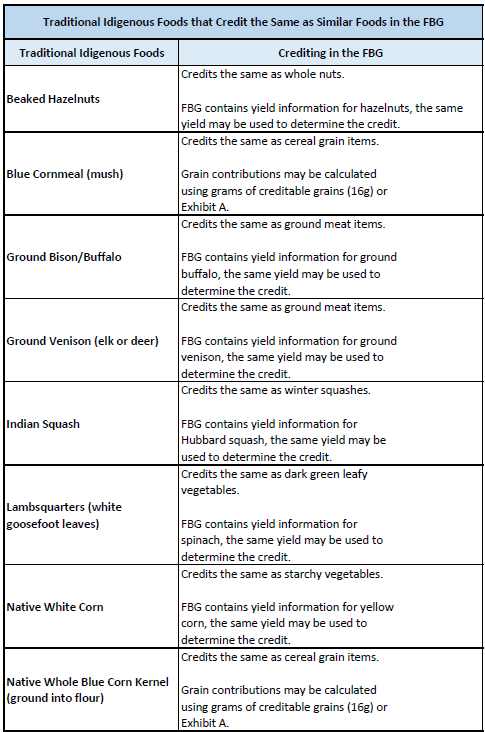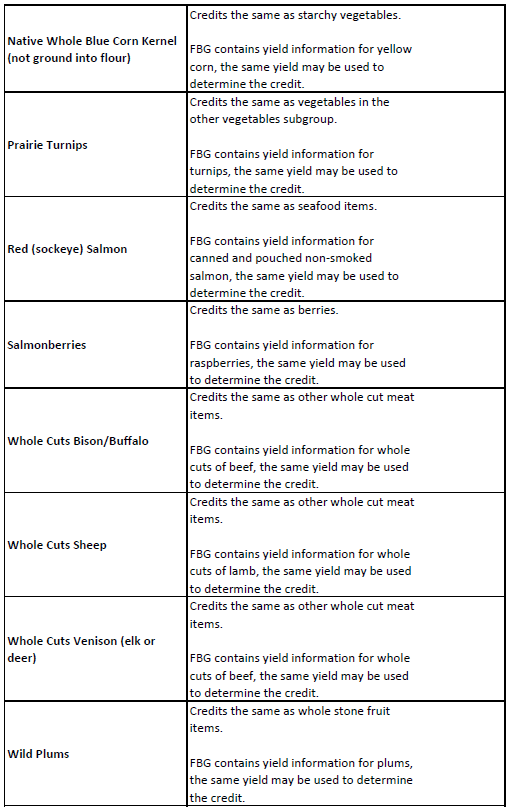Crediting Traditional Indigenous Foods in Child Nutrition Programs
November 1, 2023

Summary
The United States Department of Agriculture (USDA) released their first TA guidance memo for 2024. The memorandum provides guidance to Indigenous communities on incorporating traditional Indigenous foods that meet CNP meal pattern requirements and includes an updated and expanded list of traditional Indigenous foods that credit the same as similar foods currently listed in the Food Buying Guide for Child Nutrition Programs (FBG).
Why It Matters
Child Nutrition Programs, including the CACFP, strive to be inclusive of and adaptive to all cultures. An important aspect of this is making sure that culturally appropriates foods are being served. Indigenous groups eat certain foods that are not commonly consumed by other cultures, and those foods were not previously included in the FBG and were difficult to credit in CNPs.
In response, USDA has included traditional foods in the FBG. Not only does this list make program participation easier for indigenous groups, but it is also a great resource for any programs that serve indigenous groups.
Guidance
The United States Department of Agriculture (USDA) is transforming America’s food system with a greater focus on more resilient local and regional food production, while ensuring access to safe, healthy, and nutritious food in all communities. Part of this effort includes USDA’s commitment to support Tribal Nations’ self-determination, promote equity, remove barriers to services and programs, and incorporate Native American perspectives into food programs, recognizing their food sovereignty. USDA understands the importance of serving traditional Indigenous foods and encourages all operators of Child Nutrition Programs (CNP) to source locally grown and raised foods.
Food and Nutrition Service (FNS), in collaboration with the USDA Office of Tribal Relations (OTR), is providing this guidance to clarify how traditional Indigenous foods credit in the CNP. FNS has created a list of traditional Indigenous foods that are similar to foods in the Food Buying Guide for Child Nutrition Programs (FBG), and thus would credit the same. This is not an exhaustive list, but rather aims to showcase how to credit some traditional Indigenous foods not in the FBG by using similar foods in the FBG.
Meal Pattern Requirements
The meal pattern includes five components including fruits, vegetables, milk, meats/meat alternates, and grains. To credit toward a meal component, a food item must meet particular guidelines such as volume, grams of protein, and/or grams of carbohydrates. If it is not clear how a traditional Indigenous food may credit toward the meal pattern requirements, technical assistance is available from FNS on a case-by-case basis. Program operators should direct any questions concerning this guidance to the appropriate FNS Regional Office.
The Role of the Food Buying Guide for Child Nutrition Programs
The FBG (https://www.fns.usda.gov/tn/food-buying-guide-for-child-nutrition-programs) is an essential tool that provides food yield information for: 1) planning and calculating the required quantities of food to purchase for CNP, and 2) determining the specific contribution each food makes toward the meal pattern requirements. The FBG enables Program operators participating in CNP to comply with the Dietary Guidelines for Americans and ensure that the meal pattern requirements are met for each component of a federally reimbursable meal. The FBG includes different foods commonly used in CNP and is continually being updated with more foods and new features.
Crediting Traditional Indigenous Foods
While the FBG provides a relatively comprehensive list of foods commonly served in CNP, it does not include yield information for every possible food served in reimbursable meals. Crediting of traditional Indigenous foods that contribute to the meal pattern requirements but are not listed in the FBG may be determined using either of these methods: 1) using yield information of a similar food; or 2) conducting an in-house yield study. In these occurrences, traditional Indigenous food may credit like similar products found in the FBG, as demonstrated in the table attached to this memo.
When traditional Indigenous foods that contribute toward the meal pattern requirements are not listed and are not similar to another food in the FBG, in-house yields may be developed and used. Instructions for developing in-house yields are available online in the “About the Food Buying Guide” section on the home page of the FBG at https://foodbuyingguide.fns.usda.gov.
Traditional Indigenous Foods That do not Contribute Toward the Meal Pattern Requirements but are Allowable
Not all traditional Indigenous foods contribute toward the meal pattern requirements; however, they may still be served (e.g., meats/meat alternates, grains, milk, fruits, or vegetables). These foods may be included to round out the meal, improve acceptability, and satisfy children’s or adults’ appetites. When served in school meals, these foods must be accounted for in the weekly nutrient analysis and count toward dietary specifications (i.e., limits on calories, saturated fat, sodium, and trans fat). For example, acorns do not credit toward the meats/meat alternates component due to their low protein and iron content, but may still be served.
Acorns may be served with a reimbursable meal and must be included in the weekly dietary specifications, but they will not contribute toward a meal pattern component. Another example, maple syrup, is a traditional Indigenous food that is often used in cooking or baking and does not credit toward a specific meal component. Acorns and maple syrup may be used in reimbursable meals and must be included in the weekly dietary specifications, but they do not contribute toward a meal pattern component.
Traditional Indigenous foods may also be used during taste tests or other educational opportunities outside of the meal programs. To help children learn about where their food comes from and the cultural traditions associated with their food, USDA encourages schools to engage local, Indigenous knowledge-keepers, agricultural and ethnobotanical educators, and nutrition professionals to guide nutrition education. For more information, visit https://www.fns.usda.gov/f2s/farm-to-school.
Meat from Game Animals
Meat from both farm raised and wild game animals (e.g., bison, venison, and reindeer) may be served in CNP.
Producers selling domesticated and wild game animals to school meal programs must meet applicable Federal, State, local, and Tribal food safety regulations and inspection requirements. School food authorities should work with their local food safety authority to determine applicable State and local food safety regulations. Please note that state and local authorities may have stricter regulations than FNS, preventing the service of farm raised and wild game animals. Congress has delegated to state governments the responsibility for the administration of school meal programs. USDA is cognizant that state government rules on traditional Indigenous animal protein sources are sometimes in conflict with Tribal Sovereignty.
Adding Additional Traditional Indigenous Foods to the Food Buying Guide
In the future, FNS will add new traditional Indigenous foods and their crediting information to the FBG. USDA will also hold a Tribal consultation/listening session to ask Indian Country which additional traditional Indigenous foods should be added to the FBG.
In addition, USDA is also exploring additional opportunities that may be available for internal and/or external capacity to provide yield study research on traditional Indigenous foods.
Additional Questions
In keeping with our intent to foster diversity in USDA’s CNP and honor our trust and treaty responsibility to Tribal Nations, we encourage the inclusion of traditional Indigenous foods in CNP. We invite Tribes and stakeholders to voice any issues or concerns so that we may continue to provide technical assistance as necessary. Furthermore, USDA will continue to actively engage with Tribes and stakeholders in the school and nutrition spaces in Indian Country where possible. For additional guidance concerning this memorandum, please contact your FNS Regional Office (https://www.fns.usda.gov/fns-regional-offices) or USDA’s OTR (https://www.usda.gov/our-agency/staff-offices/office-tribal-relations-otr/contact-otr) for assistance.
Examples of Traditional Indigenous Foods that Credit the Same as Similar Foods in the FBG



Read the full guidance: Crediting Traditional Indigenous Foods in Child Nutrition Programs (TA 01-2024). For additional resources read Serving Traditional Indigenous Foods.
